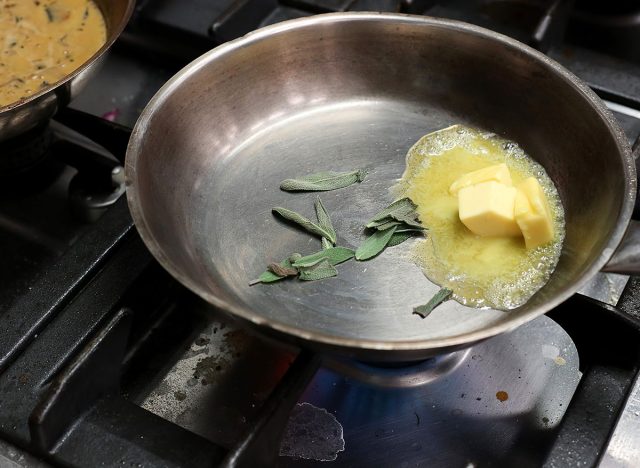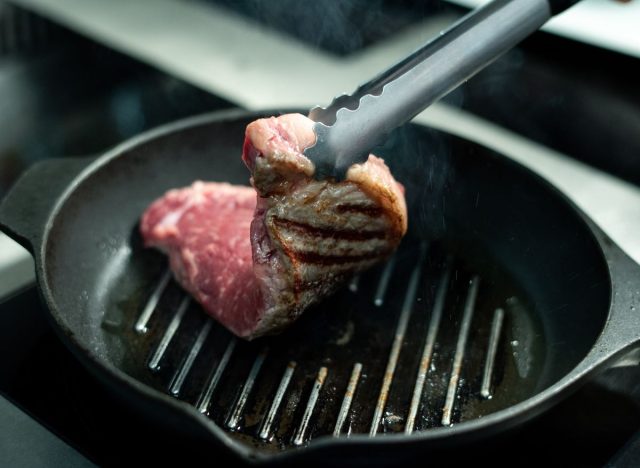If you’re new to the world of cooking steak, chances are you’ve felt overwhelmed at some point because of the process. Maybe you’ve spent a pretty penny on a nice cut of steak at the store, only to bring it home and accidentally overcook it. Or maybe you’ve gone through all the right steps but still don’t get those bold flavors you’re used to at a steakhouse.
Even though you’re probably an amazing at-home chef, there may be one or two pivotal mistakes you’re making when you cook your steak without even realizing it.
Here are five mistakes chefs say that people commonly make when they’re cooking steak. And if you need help deciding which cut of steak you should buy, check out The Best & Worst Cuts of Steak.
Cooking steak straight from the fridge
What many people may not realize is that you need to give your steak some time to get to room temperature before you cook it.
“If you pull it out of the fridge and cook it right away, it’s going to be harder to get a perfect medium rare,” says Chuck Sillari, a chef at Mortadella Head.
If you’re cooking your steak after pulling it straight our of the fridge, you could be setting yourself up for an uphill battle while standing over a hot stove.
“The heat from the pan takes longer to penetrate the meat and therefore takes longer to cook, resulting in an undercooked interior and an overdone exterior,” says Deborah Rainford, a Cordon Bleu graduate with 10 years of experience in Michelin-star kitchens throughout Europe. Instead, Rainford suggests “letting your steak come to room temperature for up to an hour before cooking to combat this.”
Dropping your steak into your pan before the oil is hot enough


If you choose to cook your steak on the stovetop, you’ll want to make sure you’re cooking it at a high enough temperature.
“When cooking steak, you want good contact between the pan and meat to create the Maillard effect, which creates the searing on your steak responsible for the flavor,” says Rainford.
Rainford claims that the key to benefitting from the delicious byproduct of a Maillard reaction is choosing the right skillet to cook your steak in.
READ RELATED: Ray Luv Height, Weight, Age, Body Statistics
“Using a heavy bottom—cast-iron is great—over medium-high heat and letting the oil get hot, just below the smoking point. Then, place the steak into the hot oil, and press it down so it makes end-to-end contact with the pan,” Rainford suggests.
Misfiring on your steak seasoning strategy
Though this may not naturally occur to you when preparing your steak, but when cooking steak, you might want to avoid cooking with dried herbs because of how easily they can burn.
“If I want an herbal touch, instead of adding dry herbs to the seasoning salt—which can burn—I’ll incorporate herbs by basting or sprinkling some fresh rosemary or thyme in the juices released when the meat is cooked and pouring it over top,” says Chris McDade, chef and co-owner of Gus’s Chop House.
Another thing to consider when seasoning your steak is to make sure you’re not putting salt seasoning on the steak too soon.
“Many people are guilty of taking the steak out and pouring on salt and pepper right away, but this is a mistake,” says Rusty Hansen, chef at Hunters Feast. “Salt extracts moisture, which will leave you with a dry steak. The best approach is to apply seasoning when the steak is already on the heat.”
Turning your steak too often


When cooking your steak in a pan, you might be tempted to repeatedly flip it over again and again in order to check on how it’s cooking. However, chefs warn that you don’t want to overdo it on the flipping, as this can actually make it more difficult to determine the extent to which your steak has been cooked.
“One method to improve your chances of cooking a delicious steak at home is trying to turn the steak only once,” says Hansen. “By constantly turning, it’s hard to gauge the doneness and you risk having it overcooked or unevenly cooked.”
Not letting your steak rest before serving
It’s easy to assume that once you’re ready to remove your steak from the heat source and plate it, that your steak is automatically ready to enjoy—but in actuality, that’s not quite the case.
“The first mistake that most new cooks make is underestimating how long you have to leave a steak to rest after it’s been cooked,” says Jenna Moran, professional chef and founder of digital culinary hub Whimsy and Spice.
To really get the best of every juicy, flavorful bite your steak has to offer, patience can be a worthwhile virtue.
“Resting steak allows all of the juices to settle, creating a wonderfully juicy piece of meat. If you cut into it straight after it’s been cooked, the juices won’t have dispersed properly, and it will end up drier,” Moran explains.
Source:








